Last updated on
Discover the pros and cons of copper kitchen sinks in this comprehensive guide to help you decide if it’s the perfect addition to your home.
Copper kitchen sinks are becoming increasingly popular among homeowners due to their unique and elegant look. But, are they just a pretty face or do they offer practical benefits as well? In this article, we will explore the pros and cons of copper kitchen sinks and help you decide whether they are a good idea for your home.
Whether you’re remodeling your kitchen or just looking for new ideas to spruce up your space, read on to find out if a copper sink is right for you.
What's Inside
Copper Kitchen Sink Overview
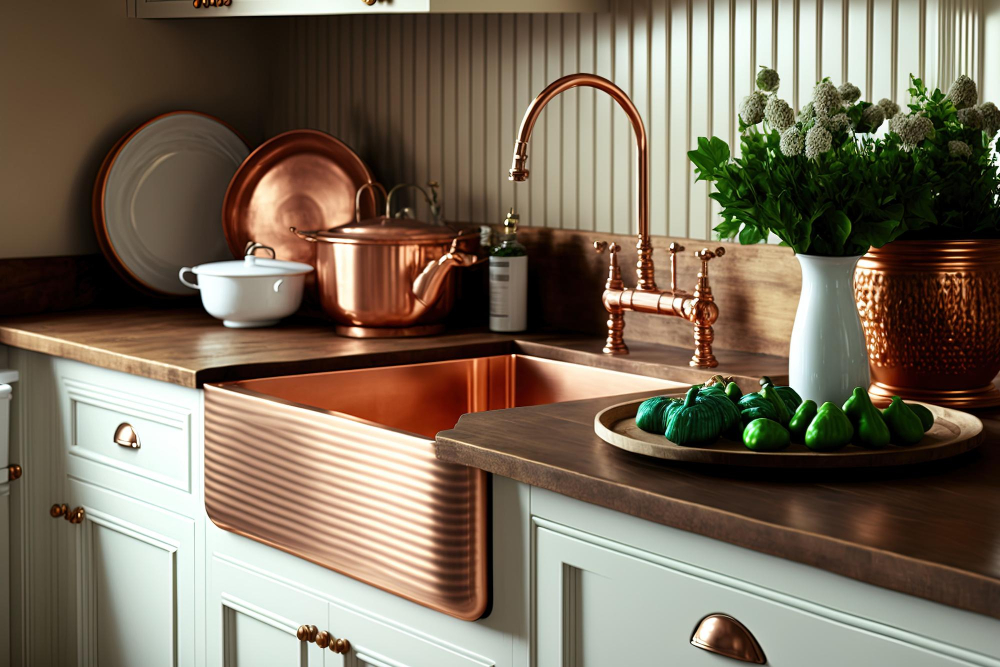
Copper kitchen sinks are a popular choice for homeowners who want to add a touch of elegance and sophistication to their kitchens. These sinks are made from high-quality copper, which is known for its durability and unique appearance.
Copper kitchen sinks come in various styles, including farmhouse, undermount, drop-in, and vessel sink designs.
One of the most significant advantages of copper kitchen sinks is their ability to resist bacteria growth due to the metal’s antimicrobial properties. This makes them an excellent choice for families with young children or those concerned about hygiene in the home.
Another benefit of copper kitchen sinks is that they are environmentally friendly since they can be recycled at the end of their lifespan. These types of sink materials require less energy during production than other materials like stainless steel or porcelain.
Benefits of Copper Sinks
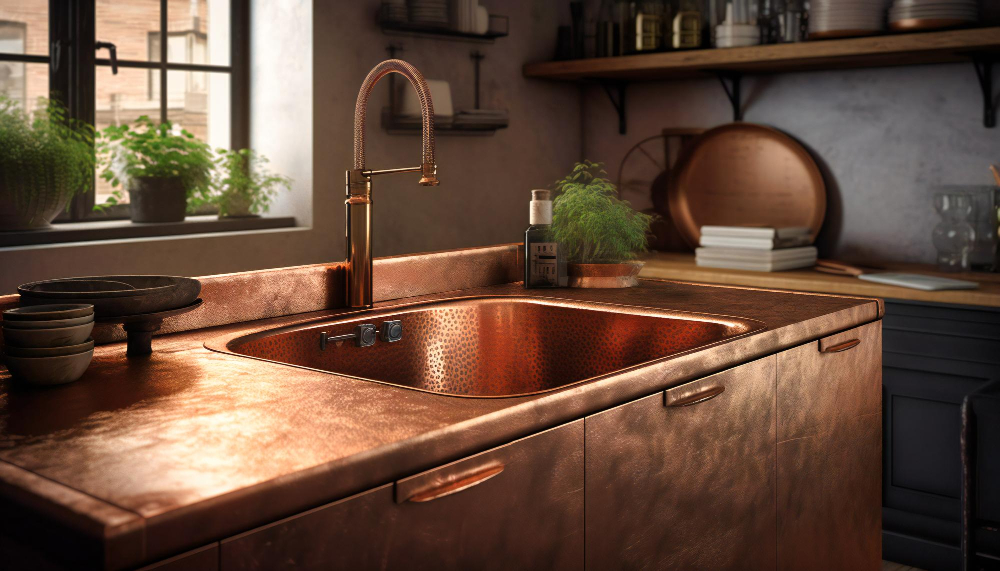
One of the most significant advantages is their unique and elegant appearance, which can add character and warmth to any kitchen. Copper sinks also have natural antimicrobial properties, making them more hygienic than other materials such as stainless steel or porcelain.
Another benefit of copper sinks is their environmental friendliness. Copper is a highly recyclable material, meaning that it can be reused without losing its quality or durability.
This makes copper an excellent choice for those who are looking to reduce their carbon footprint while still enjoying high-quality products in their home.
In addition to these benefits, copper sinks are also incredibly durable and long-lasting when properly cared for. They do not rust or corrode like other metals such as iron or steel and develop a beautiful patina over time with use.
Antimicrobial Properties

This makes copper kitchen sinks a great choice for those who prioritize cleanliness in their homes. Studies have shown that copper surfaces can eliminate up to 99.9% of bacteria within two hours of contact, making them an excellent option for busy kitchens where hygiene is essential.
In addition to being naturally antimicrobial, copper also has the added benefit of being easy to clean and maintain. Unlike other materials that require harsh chemicals or abrasive cleaners to keep them germ-free, all you need with a copper sink is some warm water and mild soap.
However, it’s important not to rely solely on the antimicrobial properties of your sink as proper cleaning practices are still necessary in maintaining good hygiene levels in your kitchen space.
Environmental Benefits
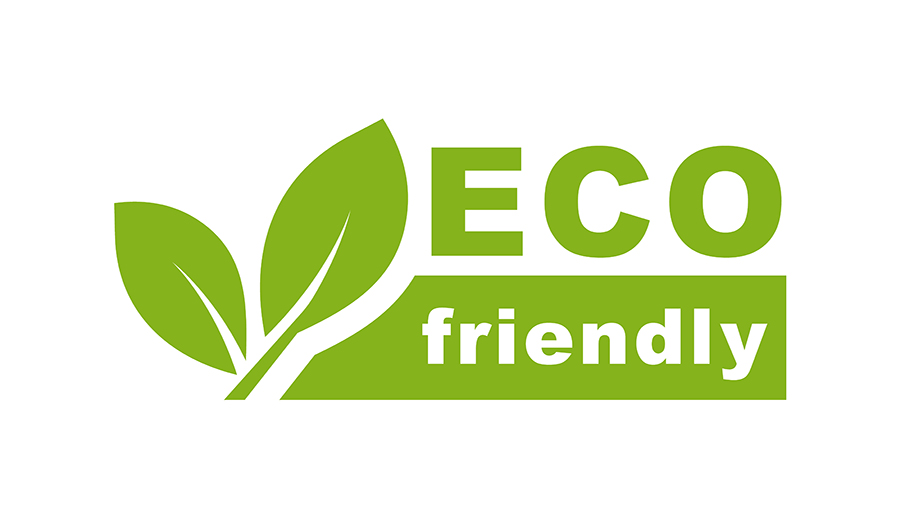
This makes copper kitchen sinks an eco-friendly choice for homeowners who are conscious of their environmental impact. By choosing a copper sink, you’re not only adding elegance to your home but also contributing to the preservation of our planet.
Moreover, copper has antimicrobial properties that make it resistant to bacteria and other harmful microorganisms. This means that you won’t have to use harsh chemicals or cleaners as often, reducing the amount of toxic substances released into the environment.
Many manufacturers now offer recycled copper sinks made from reclaimed materials such as old pipes and wires. These products help reduce waste in landfills while still providing high-quality kitchen fixtures.
Potential Drawbacks

One of the main concerns is that copper can be prone to scratching and denting more easily than other materials such as stainless steel or porcelain. This means that you may need to take extra care when using your sink, especially if you have heavy pots and pans or sharp utensils.
Another issue with copper sinks is their tendency to develop patina over time. While this can add character and charm to your kitchen, it may not be everyone’s cup of tea.
If you prefer a shiny new look for your sink at all times, then a copper sink might not be the best choice for you.
Cost can also be an issue with these types of sinks as they tend to come with higher price tags compared to other materials on the market. However, keep in mind that investing in a high-quality copper sink could potentially save money in the long run due its durability and longevity.
Copper Sink Styles
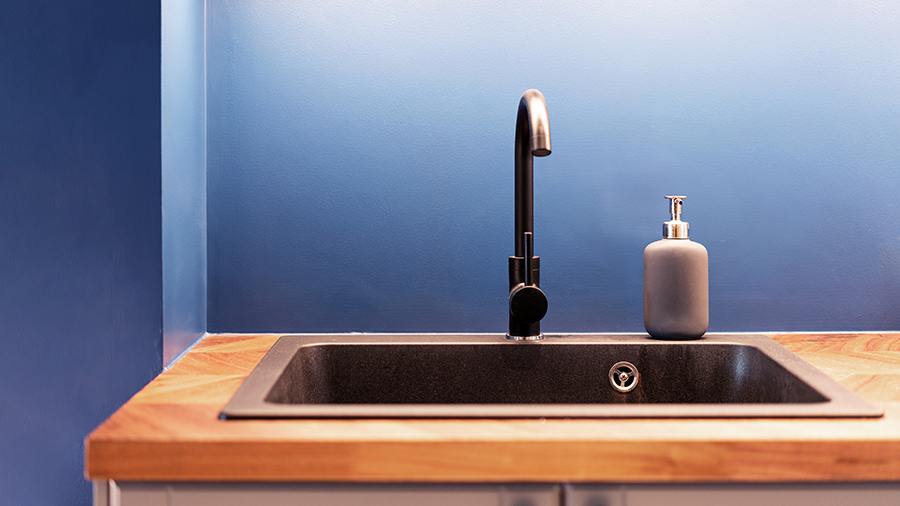
From traditional farmhouse sinks to modern undermount designs, copper can complement any decor style. Farmhouse-style copper sinks are particularly popular due to their rustic charm and durability.
They feature an exposed apron front that adds character and depth to the sink while also providing ample space for washing dishes or preparing food.
For those who prefer a more contemporary look, there are sleek undermount copper sink options available as well. These types of sinks sit below the countertop level for a seamless appearance and work well with minimalist design schemes.
Regardless of which style you choose, be sure to consider how it will fit into your overall kitchen design scheme before making a purchase decision.
Farmhouse Sink Pros and Cons

These sinks, also known as apron-front sinks, have an exposed front panel that extends past the edge of the countertop. While they offer many benefits, there are also some drawbacks to consider before making your final decision.
Pros:
- Large and deep basin: Farmhouse sinks typically have large and deep basins that can accommodate even the largest pots and pans.
- Easy access: The exposed front panel allows for easy access without having to lean over or strain your back.
- Aesthetic appeal: Farmhouse sinks add character and charm with their unique design that complements traditional or modern kitchens alike.
Cons:
- Limited counter space: The extended front panel takes up valuable counter space which may be an issue in smaller kitchens.
- Installation challenges: Installing farmhouse sink requires custom cabinetry which can increase installation costs significantly compared with standard undermount sink installations
- Maintenance concerns : Due to its size it might require more maintenance than other types of kitchen sink
Customization Options
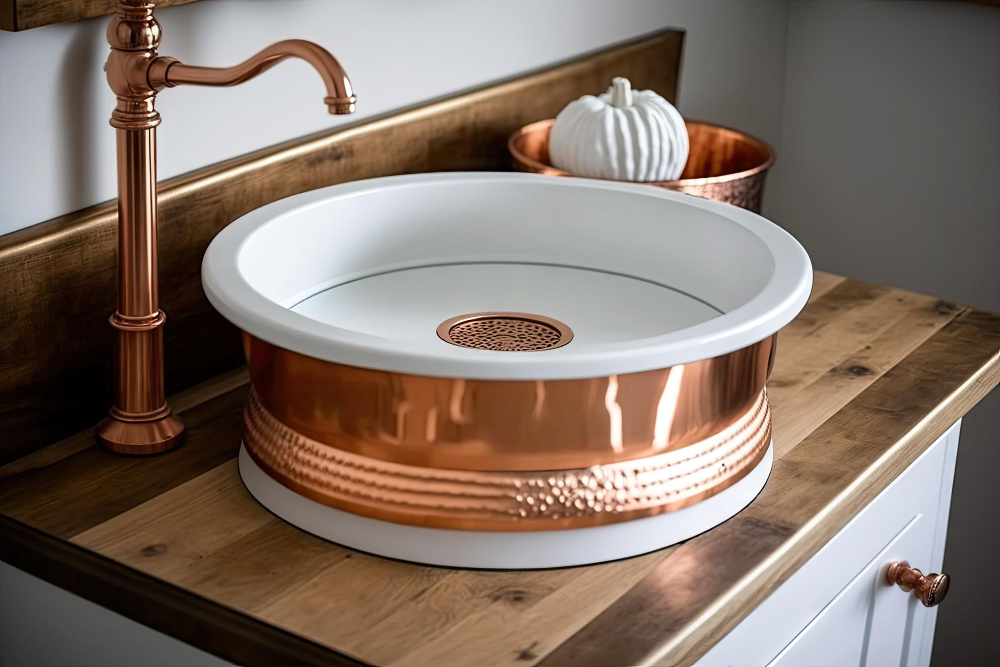
Copper can be easily molded into various shapes and sizes, making it an ideal material for creating unique sink designs that cater to your specific needs. Whether you’re looking for a traditional farmhouse-style sink or a modern vessel sink, copper can be customized to fit any style.
In addition to shape and size, there are also several other customization options available when it comes to copper sinks. For instance, you can choose from different finishes such as polished or hammered textures that add character and depth to the surface.
Moreover, some manufacturers offer custom patina finishes which allow homeowners more control over how their sink will age over time. This means that if you prefer a darker patina finish on your copper kitchen sink rather than its natural coloration after years of use – this option is available!
Durability and Quality
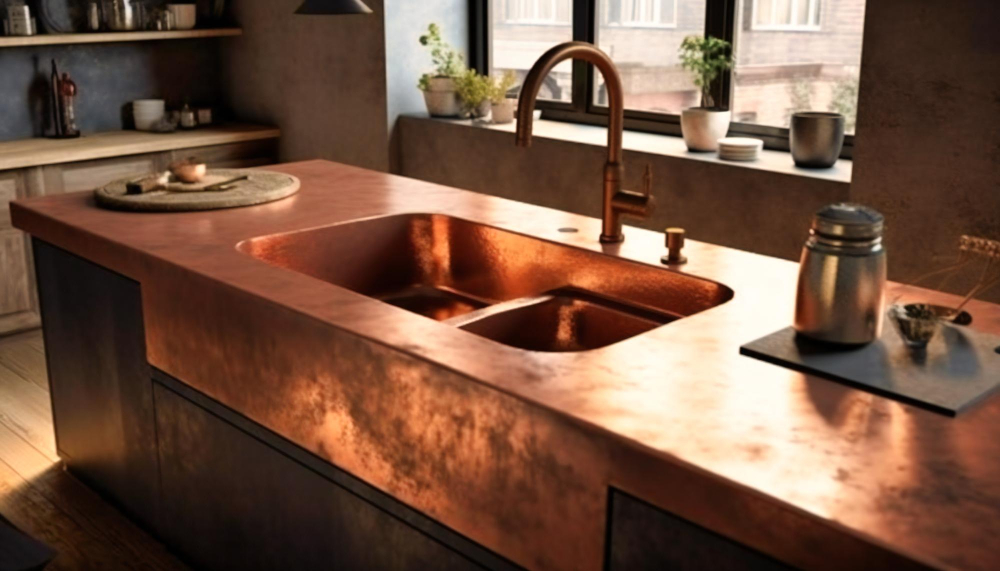
They are made from a thick gauge of copper, which makes them resistant to dents, scratches, and other types of damage. Copper is also naturally antimicrobial, meaning it can kill bacteria on contact without the need for harsh chemicals.
One thing to keep in mind when considering a copper sink is that it will develop a patina over time. This natural process occurs as the metal reacts with air and water exposure.
The patina gives the sink an aged look that many homeowners find appealing but may not be suitable for everyone’s taste.
When shopping for a copper sink, pay attention to its gauge thickness—the lower the number; thicker will be your basin walls—this ensures better resistance against wear-and-tear over time.
Copper Sink Durability
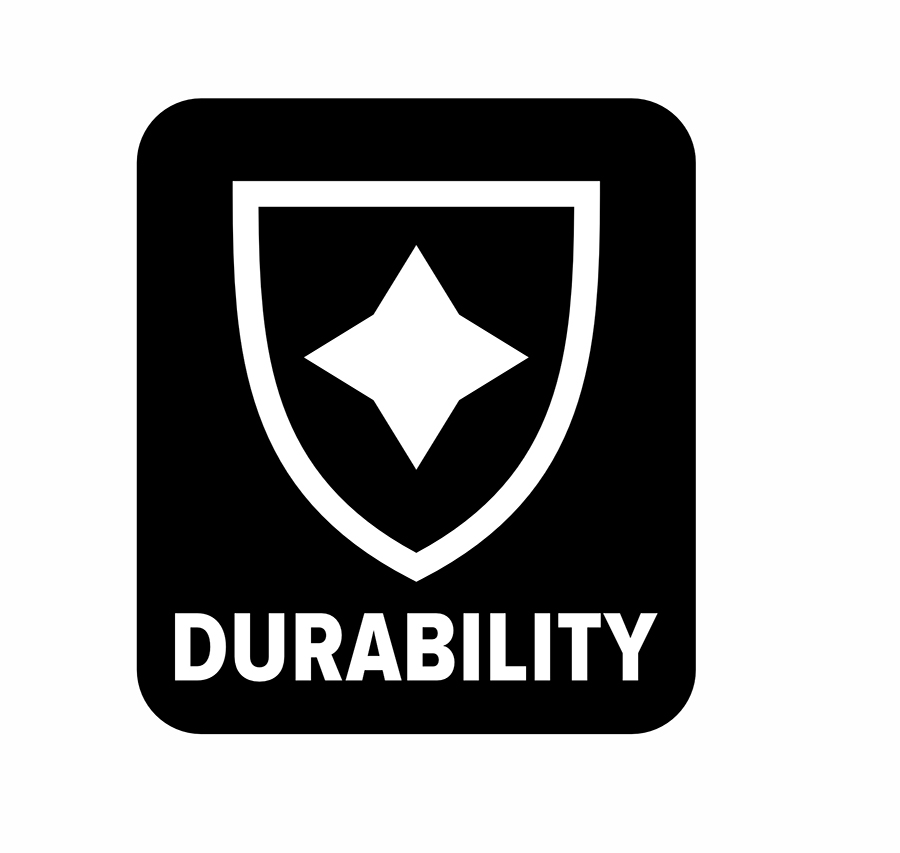
Copper is a soft metal, which means that it can be easily scratched or dented if not handled with care. However, this doesn’t mean that copper sinks are fragile and won’t last long.
In fact, many homeowners prefer copper sinks because they develop a unique patina over time that adds character and charm to the sink’s appearance. The patina also helps protect the sink from further damage by creating a natural barrier against scratches and corrosion.
To ensure your copper sink lasts for years to come, you should take proper care of it by avoiding abrasive cleaners or harsh chemicals that could damage its surface. Instead, use mild soap and water to clean your sink regularly.
Consider investing in thicker gauge (lower number) copper for added durability as thinner gauges may dent more easily under heavy use or impact.
Tarnishing and Patina
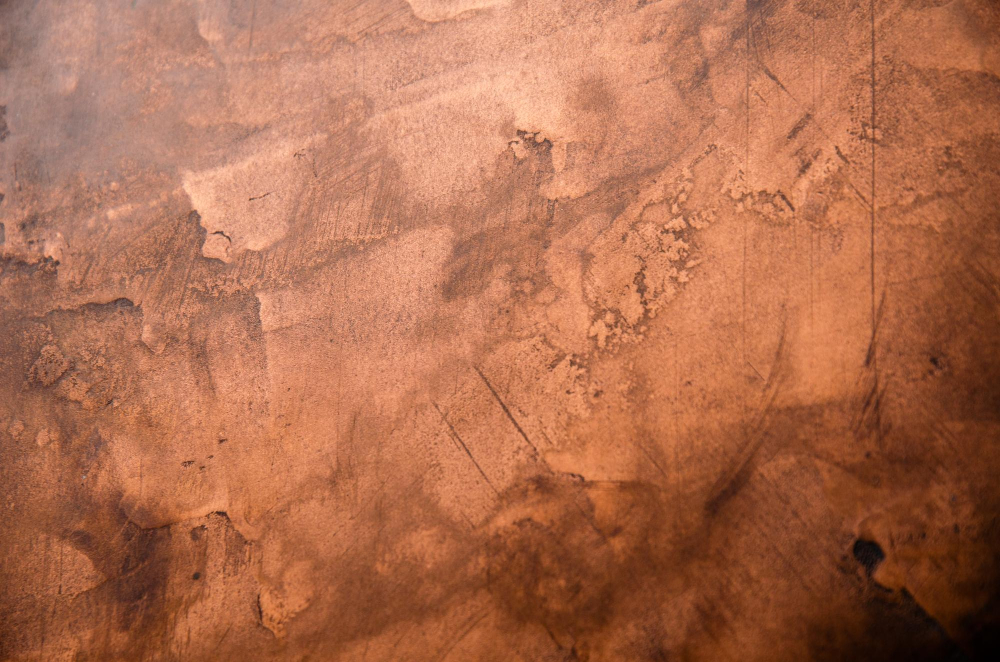
This natural process occurs when copper reacts with its environment, resulting in a change in color and texture. While some homeowners appreciate this aged look, others prefer to maintain the original shine of their sink.
It’s important to note that tarnishing does not affect the functionality or durability of your sink. In fact, it can even enhance its antimicrobial properties by creating an environment that inhibits bacterial growth.
If you prefer your sink to maintain its original luster, regular cleaning and maintenance are necessary. However, if you embrace the natural aging process of copper sinks and enjoy watching them evolve over time into a beautiful patina finish then no extra care is needed as they will continue developing on their own without any intervention from you.
Discoloration and Variations
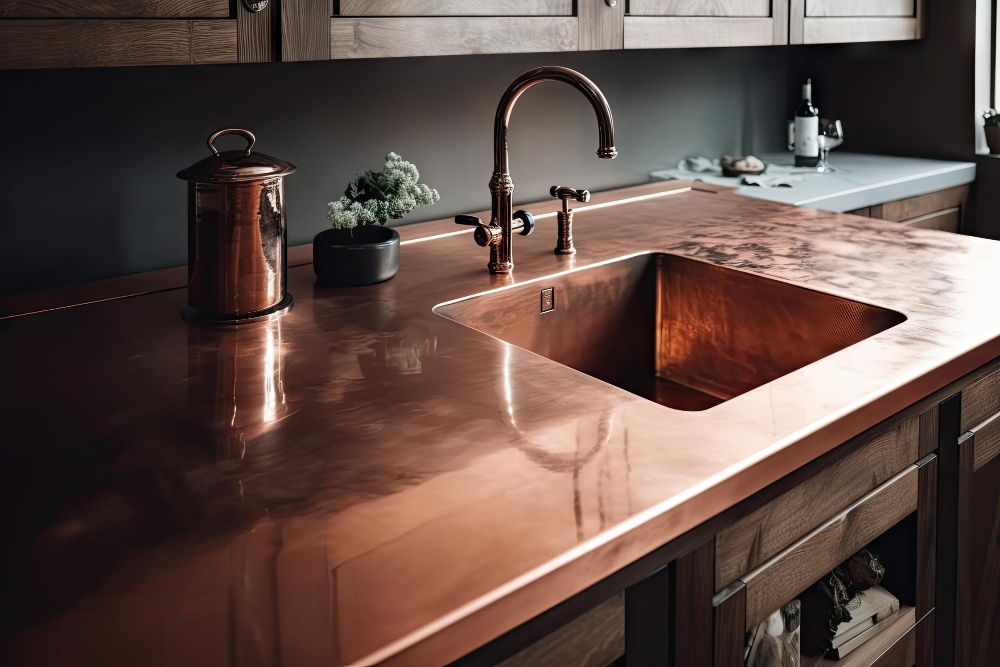
This is due to the natural patina that forms on copper when it’s exposed to air, water, and other elements. Some homeowners love this look as it adds character to their sink while others prefer a more uniform appearance.
It’s important to note that not all copper sinks will develop the same type of patina or discoloration. The amount of exposure your sink has with water, soap, acidic substances like lemon juice or vinegar can affect how quickly your sink develops its own unique look.
If you’re concerned about maintaining a consistent color in your kitchen decor scheme then consider purchasing an undermount copper kitchen sink which will be less visible than an apron front style where the sides are exposed.
Copper Sink Gauge
The lower the gauge number, the thicker and more durable your sink will be. Copper sinks typically range from 14-18 gauges with 16 being a popular choice for most homeowners.
While a thinner gauge may save you money upfront, it can also lead to dents and scratches over time. A thicker gauge sink is not only more durable but also provides better sound insulation.
It’s important to note that while a higher-gauge copper sink may seem like an unnecessary expense at first glance, investing in one can actually save you money in repairs or replacements down the line.
Size Considerations
You want a sink that fits comfortably in your countertop and provides enough space for all of your daily tasks. Before making a purchase, measure the area where you plan to install the sink and consider how much counter space you have available.
Copper sinks come in various sizes ranging from small bar sinks to large farmhouse-style models. If you have limited counter space or a smaller kitchen, then a smaller-sized copper sink may be more appropriate.
On the other hand, if you frequently entertain guests or cook large meals at home, then investing in a larger-sized copper sink can make meal prep easier.
It’s also essential to consider depth when selecting your ideal size as deeper bowls offer more room for washing dishes while shallower ones are better suited for food preparation and quick cleanups.
Installation Considerations

First and foremost, make sure that the sink fits your countertop cutout. Copper sinks come in various sizes and shapes, so measure your existing cutout carefully before purchasing one.
Another important consideration is the type of installation you want for your copper sink. There are two main types: drop-in or undermount installation.
Drop-in sinks sit on top of the counter while undermount sinks attach underneath it for a seamless look.
If you’re replacing an old sink with a new copper one, keep in mind that plumbing may need to be adjusted depending on the size and shape of your new fixture.
Lastly, if this is not something you feel comfortable doing yourself or don’t have experience with plumbing work – hire professionals! A professional plumber can ensure proper installation which will prevent leaks or other issues down the line.
Copper Sink Installation
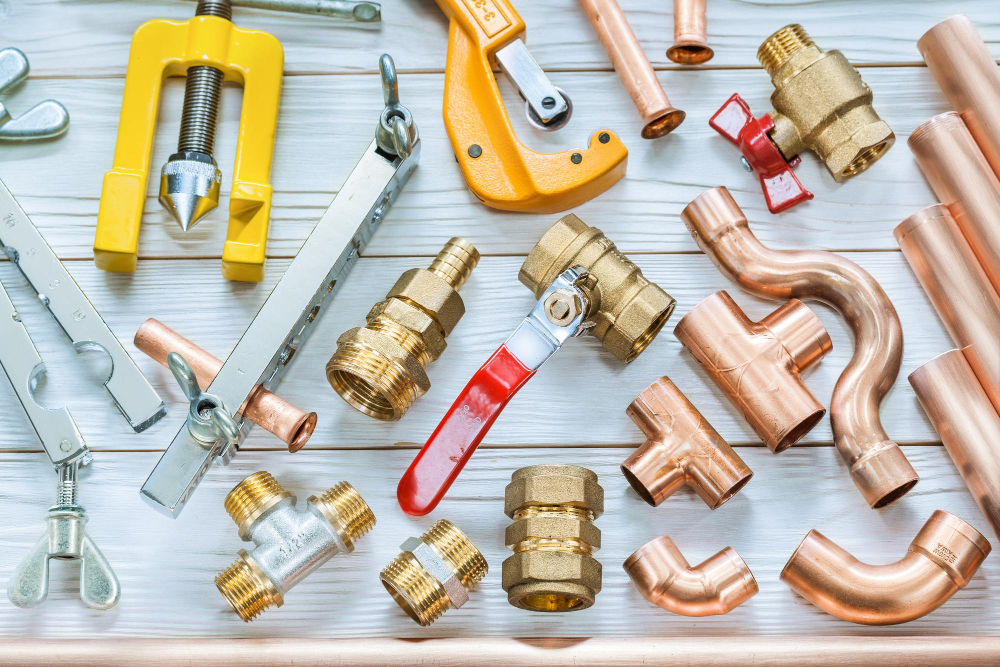
It’s important to ensure that the installation process is done correctly to avoid any potential issues down the line. If you’re replacing an existing sink with a copper one, make sure that your new sink fits into the same space as your old one.
If you’re installing a brand-new copper kitchen sink, then there are some additional considerations to keep in mind. First and foremost, make sure that you have all of the necessary tools and materials before starting on this project.
You’ll need plumbing supplies such as pipes and fittings along with silicone caulk or plumber’s putty for sealing around the edges of your new fixture once it has been installed securely onto its mounting brackets or supports underneath (depending on whether it’s an undermount or drop-in style).
Price and Budget

The price can vary depending on the size, style, gauge, and customization options you choose. On average, a copper sink can cost anywhere from $500 to $2,000 or more.
While the initial investment may seem steep compared to other materials like stainless steel or porcelain sinks that range between $100-$800; it’s important to consider the long-term benefits of owning a copper sink. Copper is durable and long-lasting which means it will not need replacing as often as cheaper alternatives.
When considering your budget for a new kitchen sink keep in mind that investing in quality materials upfront could save you money down the line by avoiding costly repairs or replacements later on.
Ultimately whether you decide to invest in a copper kitchen sink comes down to personal preference and budget constraints.
Cost of Copper Sinks

The cost of copper sinks can vary depending on the size, style, and gauge of the sink. On average, you can expect to pay anywhere from $500 up to $2,000 or more for a high-quality copper sink.
While this may seem like a steep investment at first glance, it’s important to consider the long-term benefits that come with owning a copper sink. Copper is incredibly durable and resistant against corrosion and rusting which means your investment will last for years without needing replacement.
Many homeowners find that investing in quality home decor items such as copper sinks adds value not only aesthetically but also financially when it comes time for resale.
Maintenance and Care
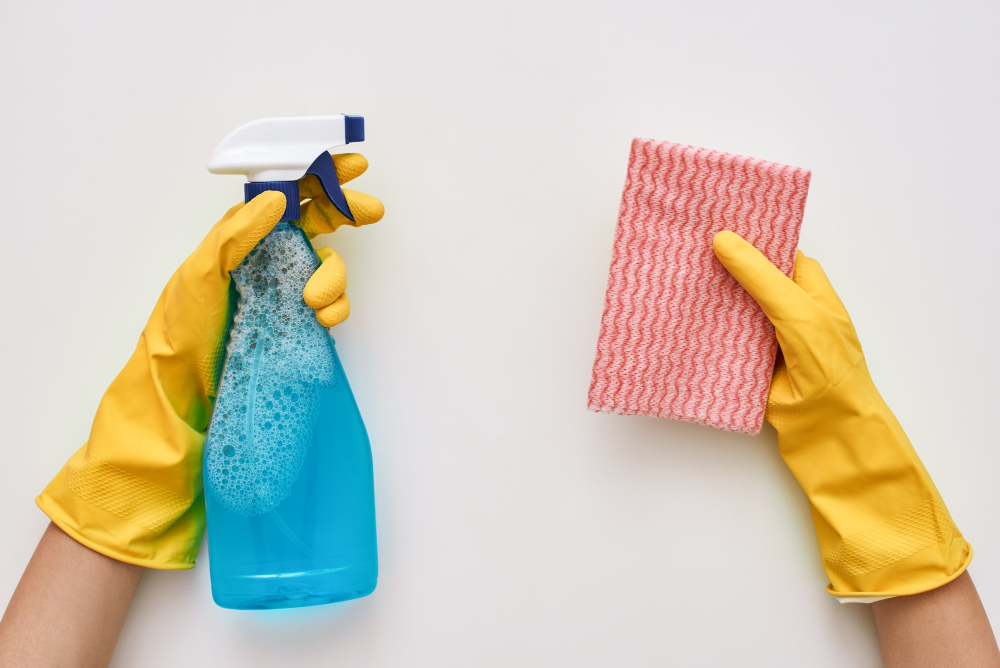
While copper is a durable material, it can tarnish over time due to exposure to air, water, and other elements. To prevent this from happening, you should clean your sink regularly using mild soap and warm water.
Avoid using abrasive cleaners or harsh chemicals that can damage the surface of the sink. Instead, use a soft cloth or sponge to gently scrub away any dirt or grime that has accumulated on the surface.
To maintain its shine and luster over time, you may want to consider applying a protective coating of wax or oil periodically. This will help protect against scratches and stains while also enhancing its natural beauty.
In addition to regular cleaning and maintenance practices at home, it’s important not forget about professional care as well. If your copper sink becomes damaged in any way such as cracks or chips in the finish then call an expert for repair services immediately before further damage occurs which could lead up costly repairs down-the-line.
Cleaning Techniques
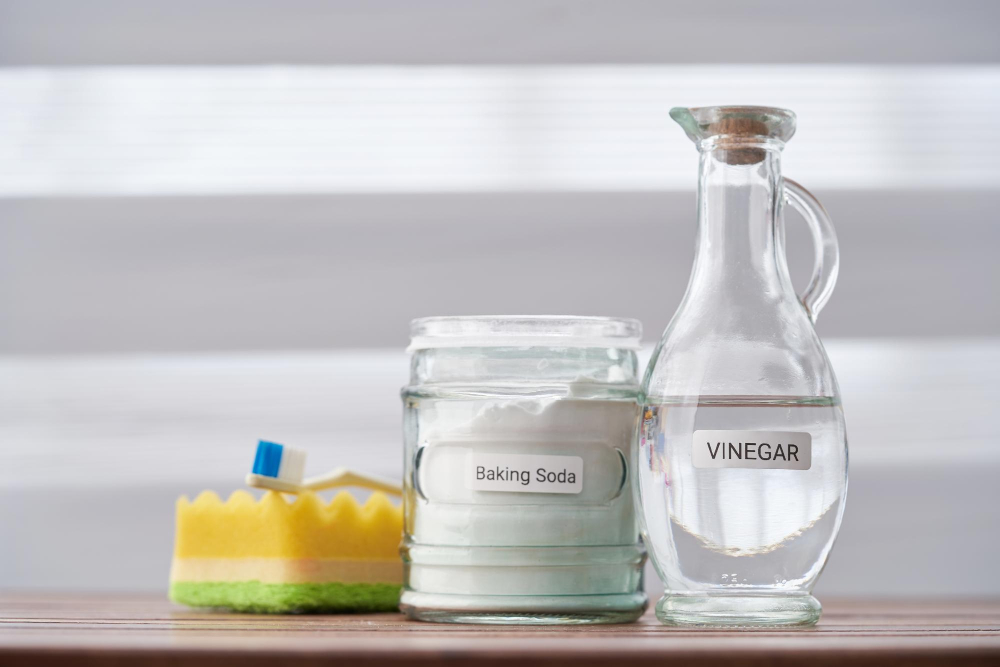
Fortunately, cleaning a copper sink is relatively easy and can be done with simple household items. Avoid using harsh chemicals or abrasive materials that can damage the surface of the sink.
To clean your copper kitchen sink, start by rinsing it with warm water and mild soap. Use a soft cloth or sponge to gently scrub away any dirt or grime on the surface of the sink.
For tougher stains, you can use a mixture of baking soda and vinegar to create a natural cleaning solution.
Another popular method for cleaning copper sinks is using lemon juice mixed with salt as an alternative cleaner that also helps remove tarnish from your copper kitchen sink’s patina layer.
After washing your copper kitchen sink thoroughly, rinse it well with warm water and dry it off completely using another soft cloth towel so no moisture remains on its surface which could lead to discoloration over time if left unattended.
By following these simple steps regularly in maintaining cleanliness in your Copper Kitchen Sink will help ensure its longevity while keeping its beautiful shine intact!
FAQ
Are copper sinks hard to keep clean?
Copper sinks are not harder to keep clean than stainless or porcelain sinks, despite common assumptions about their maintenance.
Do copper kitchen sinks turn green?
Copper kitchen sinks will not turn green if properly cleaned and cared for in indoor environments, as green oxidation is a result of harsh outdoor conditions and factors.
How do copper kitchen sinks affect overall kitchen aesthetics?
Copper kitchen sinks enhance overall kitchen aesthetics by adding a unique, warm, and timeless touch to the space.
What is the durability and longevity of copper kitchen sinks compared to other materials?
Copper kitchen sinks offer excellent durability and longevity, often outlasting other materials like porcelain and stainless steel.
Are there any copper sink maintenance tips to prevent tarnishing and scratches?
To prevent tarnishing and scratches on a copper sink, regularly clean it with mild soap, water, and a soft cloth, while avoiding abrasive cleaners and acidic substances.




